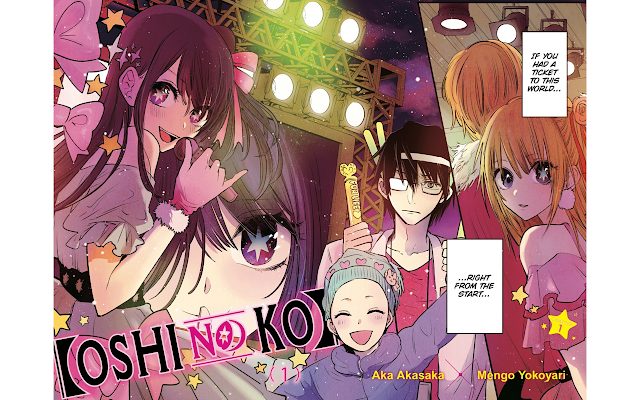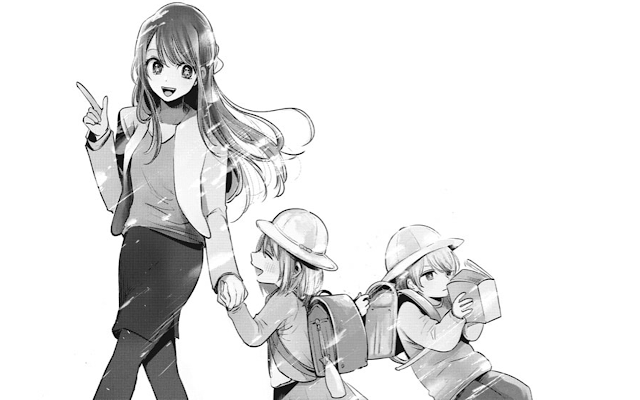Saving 80,000 Gold In Another World For My Retirement Anime/Light Novel Comparison
Welcome back to Beyond The Anime! My latest anime to light novel comparison is a Winter 2023 series with a unique spin on isekai - Saving 80,000 Gold In Another World For My Retirement. Unlike so many isekai protagonists who have no way to return from the world they suddenly arrived in to their world of origin, Mitsuha discovers her ability to teleport back and forth early in the story. This special power opens a literal wealth of opportunities for her, such as selling items from her world in the newfound fantasy world for profit, and in doing so, earn enough gold coins to retire and live comfortably.
Mitsuha dressed for battle as the Lightning Archpriestess
(light novel color illustration)
The light novel, originally released by Sol Press, has since been acquired by Kodansha and is now being released in double volumes that contain two books in one, both in print and ebook form. This is reflected in the price of the print book, but the ebook version is still the price of a single volume, which makes for a great deal, and it looks like this trend will continue in the future!
The anime adapts about two thirds of this story, so the novel does have several chapters after the big climax to show how Mitsuha comes into her new role as viscountess - granted to her by the king in the finale episode, making it worth a read for fans of the anime who want to get an idea of where the series goes from there. In addition to these "bonus chapters", Mitsuha's background receives extra detail and some of the explanations in the novel are more in depth, plus a few notable differences with the anime, for better or worse.
This image pretty much sums up Mitsuha's end goal
(light novel color illustration)
Mitsuha's background as the only remaining member of her immediate family, and the story's realistic way of portraying the effect this has on her, was the first thing that really made me feel invested in her character. The novel goes into more detail about this trying time in her life after she lost her parents and brother, and how she had to prevent other relatives from stealing her inheritance - a point which makes it clear why money holds so much importance to her as a form of security in her life. The otherworldly being that gave Mitsuha her powers also receives a slightly better explanation, with hints implying that it's actually an alien.
However, one detail that I think the anime was wise to downplay was the frequent references to people mistaking Mitsuha for a child, but at the same time showing inappropriate levels of interest in her. It was never quite clear in the anime why Mitsuha was pushed over the cliff, aside from hints that she was being bullied, but the novel shows that these boys were sexually harassing her and trying to force her to leave with them even after she pretended to be a child to deter them. There were a few men who showed an interest in Mitsuha even in the anime like the Count and his sons, and this is mostly played for laughs, but it's made worse by the novel drawing attention to the fact that they think she's only twelve years old. She's actually eighteen, though the misconception still comes off as a bit uncomfortable at times.
The narrative itself is written in a very simple style that makes this novel a fast read. Mitsuha's internal monologues are the highlights here, hilariously ranging between relatable and ridiculous depending on the topic, but her thoughts also tend to go off on long tangents at times that can distract from the overall story. Still, it was refreshing to read about a protagonist with a more practical, unconventional approach to solving problems and such a well-developed backstory right from the beginning. All of her decisions make sense given her previous experiences, sense of morality and information learned through conversations with her brother in the past.
Mitsuha with Count Bozes, his wife and sons
Some of the content that was quickly summed up in the anime did receive more lengthy explanations in the novel, such as Mitsuha setting up shop in the capital. Details were given about how she chose her storefront, made an underground storage space for her funds, and even provided a crafter from the fantasy world with blueprints of the modern devices she wanted him to create (which seems like an awfully big risk for someone who should be trying to keep her status as a person from another world secret). These tidbits were interesting, but the middle chapters that focus on the business aspect were still the weakest ones for me.
The first major change I came across was during the lead in to Mitsuha meeting Count Bozes and his family. In the anime, she tricked the Count's men into believing she was hit by their carriage in order to gain entrance to their home - one of her more dubious plans. It was surprising to find that this morally questionable moment was an anime-only addition not present in the novel at all, and their first meeting was much more straightforward. Another minor difference was the translation of her "Messenger of Lightning" title as "Lightning Archpriestess" in the novels.
Mitsuha pressures the mercenary captain to help her by stealing his truck
The most shocking differences, however, took place during the final episodes of the anime - the battle to defend the capital from an invading army, and everything leading up to it. Mitsuha enlisted the help of Wolf Fang, the mercenary group she had worked with throughout the story, but in the anime, the Captain doesn't believe the story she tells him about teleportation and the other world. In order to convince him, Mitsuha jumps into one of their armored vehicles and transports both of them (along with the truck) to the fantasy world, where he sees and fights a band of the invading goblins for himself while defending a wagon of travelers. This was one of my favorite scenes, and I was surprised to find it was anime-original. The novel just has Mitsuha teleport into the room with Wolf Fang present, removing any doubt about her powers.
The final battle itself was longer in the novel, and yet not quite as over-the-top as the anime portrayed it. Yes, there are still armored trucks and powerful guns taking on an army of fantasy monsters, but the novel does maintain more realism in the sense that Mitsuha's only role is delivering orders rather than leaping into battle herself with a bazooka. (Although I loved that scene as well and was a little disappointed not to see it here.) The version of the climactic battle in the novel, on the other hand, had some interesting background about the dragons that the anime left out. Not just one, but three dragons were present, and while two of them were killed, the leader slayed by Mitsuha in the anime was actually allowed to escape in the novel, and segments written from the dragon's point of view expanded the lore of this fantasy world. The mercenaries from Wolf Fang also brought back the entire body of a dragon back with them to Earth, instead of only a fang like the anime shows.
Mitsuha teleports into the air and fires a bazooka at a dragon in the final battle
The start of the post-anime content was one of the most exciting parts of the book for me. As the wagon Mitsuha is traveling in gets attacked by bandits on the way to her new territory, she and the other passengers must fight to eliminate the threat. It provides additional information on the aftermath of the short war, in which many of the invaders - whether soldiers, hired mercenaries or conscripted citizens - who fled from the battle but didn't make it back across the border have turned to a life of crime. There's also a great exploration of the different mindsets of Mitsuha's fellow passengers and what led to their individual decisions to fight back, from the farmer protecting his wife and daughters to the mercenary and the old man who seems like he has something to atone for.
After that, the story focuses on showing how Mitsuha adjusts to her role as viscountess and to ruling her new territory, appropriately named Yamano County. These segments are interesting, though not as exciting. There were a few outlandish but funny parts, like Mitsuha starting a blog on Earth about her experience as a viscountess, which earns her some suggestions from experts who think they're playing a game - until Mitsuha offers to bring them to the other world with her. Several of these final chapters detail Mitsuha's advancements in agriculture, the growing fishing industry, the economy and interactions with the people living there, so if you enjoyed Mitsuha's business ventures in the anime, then these chapters will have a similar vibe. Otherwise, this part of the story might feel a little slow.
The most intriguing sequel hook came in the final chapter, when Mitsuha is approached by multiple intelligence agencies from different nations on Earth (thanks to Wolf Fang selling those dragon parts) wishing to establish relations with the other world - or in some cases, perhaps take control for themselves. The way Mitsuha handles the situation is amusing, and the new realization about her healing powers was a cool surprise.
Two bonus stories are also included at the end. The first expands on Mitsuha's feelings towards Collete as the closest thing she has to family right now, which helps explain why she became attached to the girl so fast, and the second is a fun story told from the mercenary captain's point of view as they try to figure out just who this mysterious Mitsuha is exactly, with plenty of humorous banter and the nice bonus info that their defense of the kingdom earned them enough gold to allow them a long break from dangerous missions. Because this is a double length book, it has the author's afterwards for both volumes 1&2 - a nice attention to detail that is often absent in this format.
Mitsuha novel illustration
The art of the novels is simple but pleasant, with illustrations that often solely feature Mitsuha with different expressions, and the backgrounds are sparse. Mitsuha does have a nice character design, but I would have liked to see more variety. There are a few more dynamic pieces of art, like the dragon illustration and the scene where Alexis Bozes shields Mitsuha from an assassin's arrows, though these are few. The anime did better in this respect, creating a more detailed image of the world Mitsuha lives in. While there was little truly fantastic or eye-catching, the artwork was still good overall.
For anyone who enjoyed the anime and wants to know how Mitsuha's adventure continues after being made viscountess, I would definitely recommend checking out the novel. There's a great deal of content that takes place after the anime's finale, which keeps the story feeling fresh, and it maintains a good balance between adventure, kingdom-building and humor. Check out the rest of my Winter 2023 anime comparisons for Sugar Apple Fairy Tale, Tomo-chan Is A Girl and Kaina of the Great Snow Sea, and stay tuned for my next Winter 2023 anime/light novel comparison, Endo and Kobayashi Live: The Latest on Tsundere Villainess Lieselotte!




















.png)


